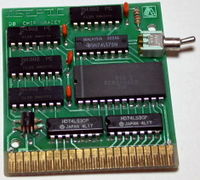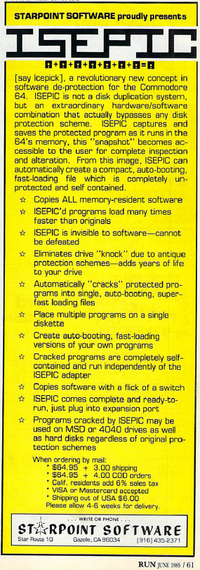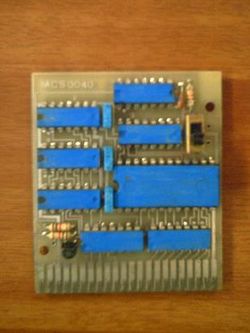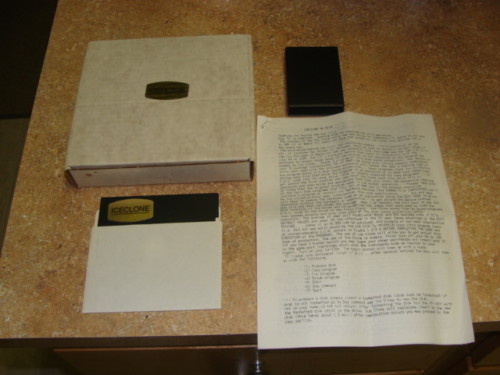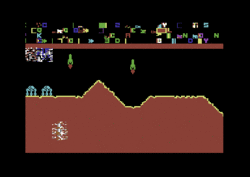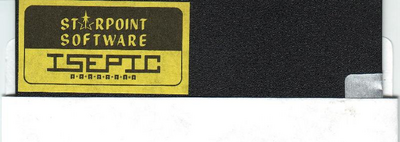ISEPIC: Difference between revisions
Count Zero (talk | contribs) m (→Binaries) |
Count Zero (talk | contribs) m (→Trivia) |
||
| Line 175: | Line 175: | ||
[[File:Isepic_Scramble_fail.gif|250px|No cart is perfect]] | [[File:Isepic_Scramble_fail.gif|250px|No cart is perfect]] | ||
* Trilogic advertised operating system software on disk as cheaper to upgrade. ''ISEPIC'' took the lead and provided a single program which nobody ever seem to have touched, modified or anything: | * Trilogic advertised operating system software on disk as cheaper to upgrade. ''ISEPIC'' took the lead and provided a single program which nobody ever seem to have touched, modified or anything (apart from some text hacking/sector editing: | ||
[[File:Isepic_Disk_small.png|400px|ISEPIC System Software was coming on a disk]] | [[File:Isepic_Disk_small.png|400px|ISEPIC System Software was coming on a disk]] | ||
== Weblinks == | == Weblinks == | ||
Revision as of 23:00, 23 October 2024
| One switch to rule them all. |
|---|
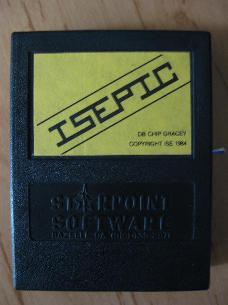
|
| Designed by Chip Gracey |
ISEPIC (say "ice-pick") is an extraordinary hardware and software combination that is capable of copying virtually all memory-resident software regardless of the original protection scheme or storage medium are the first few words on the manual.
And for once you can believe in what that sentence stated in 1985. Freezing programs is the sole purpose ISEPIC was created for and it does it pretty well.
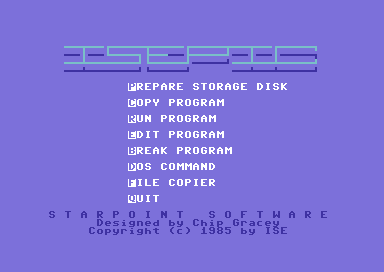 ISEPIC Screenshots | |
| Technical Info | |
|---|---|
| RAM | 2 kbyte |
| Hardware features | 1 Switch |
| Manual | PDF: 14 pages - english PDF: 08 pages - italian |
| CRT ID | NONE |
| Control Registers | $DE00 - $DE07 for RAM banking |
Commercially distributed by Starpoint Software in likely June 1985 it vanished very quickly again by the end of 1985. The manual has the name of the hard- and software designer written all over it and nowadays the website of Parallax Inc. has an article on their origins explaining how Charles 'Chip' Gracey started that company and what he did before:
These experiences quickly led to dismantling video game source code and household electronic hardware, and trying to use these devices for purposes other than originally intended. Hobby transformed into a business, and by the time he was a senior in high school Chip was running a small business called Innovative Software Engineering (ISE) from his bedroom. ISE made a software duplication hardware for the Commodore 64 computer called the ISEPIC (no relation to PICmicros). Within a year Chip sold 20,000 ISEPICs around the world, largely by word of mouth at local computer clubs and niche magazines.
Starpoint Software sold ISEPIC for just about six months and we are not sure how many units entered the world but it was enough to worry some people. The RAM-only cartridge came with monitor software (really worth a look!) and easened many tasks on a very basic level. Before actually breaking the currently frozen program it can be run again to see wether the saved snapshot would actually work. Since all operations are done on a disc ISEPICking is a very lengthy process and the common cycle of freeze, monitor inspect the memory, restart established with later cartridges was a real no-go.
Many real crackers regarded the use of a freezing cartridge as being lame but interestingly only one demo so far by FAIF (Federation against ISEPIC & Freeze Frame) was found. On the other hand several Anti-Isepic tools can be found which actually hide the fact that ISEPIC was used.
Tech
The following is shamelessly ripped from isepic.c from the VICE emulator. The text is likely written by Marco van den Heuvel:
Isepic is a ram based freeze cart. It has 2KB of ram which is banked into a 256 byte page in the $DF00-$DFFF area. The page is selected by any kind of access to the I/O-1 area, as follows: PAGE ACCESS ADDRESS ---- -------------- 0 $DE00 1 $DE04 2 $DE02 3 $DE06 4 $DE01 5 $DE05 6 $DE03 7 $DE07 Because of the incomplete decoding this 8 byte area is mirrored throughout $DE08-$DEFF. The isepic cart has a switch which controls if the registers and ram is mapped in. When the switch is switched away from the computer the cart is put in 'hidden' mode, where the registers, window and ram is not accessable. When the switch is switched towards the computer the cart is put in ultimax mode, with the registers mapped, and the current page being mapped into any unmapped ultimax memory space, it will also generate an NMI. Which activates the freezer.
The system software offers to prepare storage disk which will soft format the disk in the drive and save an ISEPICked version of the system software to it. Choosing copy program will put the actual freeze routines to cartridge RAM, fill the C64 memory with a pattern and reset the computer. The program to be copied can be loaded now.
Flipping the switch (a few times you will be told) snapshots the memory and starts saving it to the storage disk. The frozen memory is saved to disk in four chunks of 16kb each (named PGM.0 to PGM.3). Color ram is saved to "PGM.C" and the register contents can be found inside "PGM.X". These 6 files are required to use operations such as run, edit and break program with the system software.
(TODO: Outline the memory fill routine. IseMON is detecting free bytes and shows them inverted by some obscure algorithm.)
Notes
- The review on Ahoy! Magazine Issue 22 (October 1985) and Ahoy! Magazine Issue 27 (March 1986) are warning the readers and users of cartridges such as the ISEPIC to utilise them for making illigitimate backups.
- RUN Magazine Issues 18 to 24 contained adverts for the ISEPIC cartridge. At Issue 22 the advert slightly changed by replacing the words "copies" and "cracked" by "back up". In 1986 no advert was seen anymore.
Binaries
ISEPIC_binaries_rr.c64.org_2022-09.rar contains just the c64 binaries:
- Starpoints' standard ISEPIC program which includes all the functionality (operating system and tools)
- Isepic Trainer-Maker by Flash Cracking Group
- Poor Man's Isepic - archives include a fixed unfrozen version.
- ISEPIC main program text hacked by Ace and in an italian version by Alfred
- Several Defrosters/Anti-ISEPICker/Onefile generators
- The Ise-Picker 1.0 by The Dark-Angle of Dynamic Duo
- ISEPIC Defroster by the Nutcrackers
- Anti ISEPIC V1.0 and Anti-ISEPIC V2.0 by Seven Up Crew
- Anti-ISEPIC (no credits found - this program hooks into the load vector, so don't be confused after RUN by the blinking cursor.)
- Anti ISEPIC by Danish Elite
- Anti-ISEPIC V1.1 by Top of German Spreading Service
- Anti-ISEPIC V3.0 by Computerbrains Cracking Service
- ISEPIC Textboot Maker by German Spreading Service
- Why ISEPIC/CT V1 by Federation Against Copyright
- Why ISEPIC II by Federation Against Copyright & Teesside Cracking Service
- Why ISEPIC/CT V2.4
- Why ISEPIC 2.5 by Niwa Soft (text edited and newly compiled V2.4 it seems)
- Why ISEPIC Tape (italian) by OpalSoft
- ISEPIC Fixer by 29 Software (now with BASIC source!)
- ISEPIC Cruncher (no credits)
- ISEPIC File Copier v2.1 by Scott Blum
- Ent-ISEr v2.0 by CPM
- ISEPIC-Files-Changer by I-S-P'86
- ISEPIC Customizer by Emerald Warrior
- ISEPIC Customizer by Dungeonmaster
- Turbo Picker V1.2 by D.S. Compware
- Turbo Picker V2.0 by We Against Software Protection (WASP)
- ISEPIC Editor by Cale Hoopes - cracked versions by Pira Soft and by Pizzaz Pirate
- F.A.I.F. '87 Demo by the Federation against ISEPIC & Freeze Frame
- Isepic Demo by D.S. Compware promoting the Turbo Picker V1.2
- A german ISEPICed (and normal) manual for ISEPIC and ISEmon by SCA (Swiss Cracking Associates)
ISEPIC_all_rr.c64.org_2022-09.rar contains:
- all of the above
- PDF: 14 pages - english
- PDF: 08 pages - italian
- ISEPIC Manual Project64 Text
- Datasheets, photos of original ISEPIC board, PCB pictures and preliminary schematics AND ISEPIC Schematics
Thanks to Acidchild for finding different versions and new programs for the list above!
Trivia
- ISEPIC cloning was said to be common back then - where are the schematics? (Here we have two shots at different clones so far.)
- Interesting effects can be seen on failed freezes:
- Trilogic advertised operating system software on disk as cheaper to upgrade. ISEPIC took the lead and provided a single program which nobody ever seem to have touched, modified or anything (apart from some text hacking/sector editing:
Weblinks
- ISEPIC at c64-wiki.de (no english version yet)
- ISEPIC at CSDb
- ISEPIC at Retroport.de
- Italian Manuals at ready64.it mirrored at archive.org (and content here of course)
- ISEPIC and Chip Gracey history at archive.org
- Short ISEPIC post about the original at c64copyprotections.com
- ISEPIC post about the 2017 clone at c64copyprotections.com
